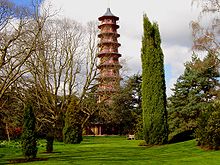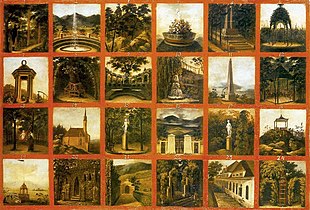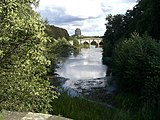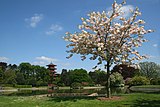English landscape garden


The English landscape garden, also called English landscape park or simply the English garden (French: Jardin à l'anglaise, Italian: Giardino all'inglese, German: Englischer Landschaftsgarten, Portuguese: Jardim inglês, Spanish: Jardín inglés), is a style of "landscape" garden which emerged in England in the early 18th century, and spread across Europe, replacing the more formal, symmetrical French formal garden which had emerged in the 17th century as the principal gardening style of Europe.[1] The English garden presented an idealized view of nature. Created and pioneered by William Kent and others, the "informal" garden style originated as a revolt against the architectural garden and drew inspiration from paintings of landscapes by Salvator Rosa, Claude Lorrain, and Nicolas Poussin.[2][3][4]
The English garden usually included a lake, sweeps of gently rolling lawns set against
History

The predecessors of the landscape garden in England were the great parks created by Sir
William Kent and Charles Bridgeman
The new style that became known as the English garden was invented by landscape designers
William Kent (1685–1748) was an architect, painter and furniture designer who introduced
Charles Bridgeman (1690–1738) was the son of a gardener and an experienced horticulturist, who became the Royal Gardener for

Chiswick House
Kent created one of the first true English landscape gardens at Chiswick House for Richard Boyle, 3rd Earl of Burlington. The first gardens that he laid out between 1724 and 1733 had many formal elements of a garden à la française, including alleys forming a patte d'oie and canals, but they also featured a folly, a picturesque recreation of an Ionic temple set in a theatre of trees. Between 1733 and 1736, he redesigned the garden, adding lawns sloping down to the edge of the river and a small cascade. For the first time the form of a garden was inspired not by architecture, but by an idealized version of nature.[8]
Rousham

Stowe House


Stowe Gardens, in Buckinghamshire, (1730–1738), was an even more radical departure from the formal French garden. In the early 18th century, Richard Temple, 1st Viscount Cobham, had commissioned Charles Bridgeman to design a formal garden, with architectural decorations by John Vanbrugh. Bridgeman's design included an octagonal lake and a rotunda (1720–21) designed by Vanbrugh.
In the 1730s, William Kent and James Gibbs were appointed to work with Bridgeman, who died in 1738. Kent remade the lake in a more natural shape, and created a new kind of garden, which took visitors on a tour of picturesque landscapes. It eventually included a Palladian bridge (1738); a Temple of Venus (1731) in the form of a Palladian villa; a Temple of Ancient Virtues (1737), with statues of famous Greeks and Romans; a Temple of British Worthies (1734–1735), with statues of British heroes; and a Temple of Modern Virtues, which was deliberately left in ruins, which contained a headless statue of Robert Walpole, Cobham's political rival.[11]
The garden attracted visitors from all over Europe, including Jean-Jacques Rousseau. It became the inspiration for landscape gardens in Britain and on the Continent.
Stourhead
Stourhead, in Wiltshire (1741–80), created by banker Henry Hoare, was one of the first 'picturesque' gardens, inspired to resemble the paintings of Claude Lorrain. Hoare had travelled to Italy on the Grand Tour and had returned with a painting by Claude Lorrain. Hoare dammed a stream on his estate, created a lake, and surrounded the lake with landscapes and architectural constructions representing the different steps of the journey of Aeneas in the Aeneid by Virgil.[12]
The great age of the English garden
Capability Brown
The most influential figure in the later development of the English landscape garden was
Brown's contribution was to simplify the garden by eliminating geometric structures, alleys, and parterres near the house and replacing them with rolling lawns and extensive views out to isolated groups of trees, making the landscape seem even larger. "He sought to create an ideal landscape out of the English countryside."[13] He created artificial lakes and used dams and canals to transform streams or springs into the illusion that a river flowed through the garden.
He compared his own role as a garden designer to that of a poet or composer. "Here I put a comma, there, when it's necessary to cut the view, I put a parenthesis; there I end it with a period and start on another theme."[14]
Brown designed 170 gardens. The most important were:
- Petworth (West Sussex) in 1752;
- Chatsworth (Derbyshire) in 1761;
- Bowood (Wiltshire) in 1763;
- Blenheim Palace (Oxfordshire) in 1764.
Humphry Repton


Humphry Repton (21 April 1752 – 24 March 1818) was the last great English landscape designer of the eighteenth century, often regarded as the successor to Capability Brown.[15] Repton hit upon the idea of becoming a "landscape gardener" (a term he himself coined) after failing at various ventures and, sensing an opportunity after Brown's death, was ambitious to fill the gap and sent circulars round his contacts in the upper classes advertising his services. To help clients visualize his designs, Repton produced 'Red Books' (so called for their binding)[16] with explanatory text and watercolors with a system of overlays to show 'before' and 'after' views.[17]
In 1794
Repton published four major books on garden design: Sketches and Hints on Landscape Gardening (1795), Observations on the Theory and Practice of Landscape Gardening (1803), An Inquiry into the Changes of Taste in Landscape Gardening (1806) and Fragments on the Theory and Practice of Landscape Gardening (1816).
The "forest or savage garden"

One aspect of the new style was making woodland more interesting and ornamental, leading to the establishment of the
The appropriate style of garden buildings was Gothic rather than Neoclassical, and exotic planting was more likely to be evergreen conifers rather than flowering plants, replacing "the charm of bright, pleasant scenery in favour of the dark and rugged, gloomy and dramatic".[21] A leading example of the style was Studley Royal in North Yorkshire, which had the great advantage, at what was known as "The Surprise View", of suddenly revealing a distant view from above of the impressive ruins of Fountains Abbey.[22]
At Stowe, Capability Brown followed the new fashion between 1740 and 1753 by adding a new section to the park, called Hawkwelle Hill or the Gothic promenade, with a Gothic revival building.[23] Walpole had decided in 1751 "to go Gothic", as he put it in a letter, and thereafter was a leading propagandist for the style, with his own house, Strawberry Hill in Twickenham, still the most extreme example of 18th-century "Gothick" style.[24]
The "Anglo-Chinese" garden

According to some writers, especially French ones, the
The novelty and exoticism of Chinese art and architecture in Europe led in 1738 to the construction of the first Chinese-style building in an English garden, in the garden of Stowe House, at a time when chinoiserie was popular in most forms of the decorative arts across Europe. The style became even more popular thanks to William Chambers (1723–1796), who lived in China from 1745 to 1747, and wrote a book, Designs of Chinese Buildings, Furniture, Dresses, Machines, and Utensils. To which is annexed, a Description of their Temples, Houses, Gardens, &c. published in 1757. In 1761 he built the Great Pagoda, a Chinese house and garden in Kew, London, as part of Kew Gardens, a park with gardens and architecture symbolizing all parts of the world and all architectural styles. Thereafter Chinese pagodas began to appear in other English gardens, then in France and elsewhere on the continent. French observers coined the term Jardin Anglo-Chinois (Anglo-Chinese garden) for this style of garden.[27][30]
The English garden spreads to the continent

Descriptions of English gardens were first brought to France by the Abbé Le Blanc, who published accounts of his voyage in 1745 and 1751. A treatise, and tour guide, on the English garden, Observations on Modern Gardening, written by Thomas Whately and published in London in 1770, was translated into French and German in 1771. After the end of the Seven Years' War in 1763, French noblemen were able to voyage to England and see the gardens for themselves, and the style began to be adapted in French gardens. The new style also had the advantage of requiring fewer gardeners, and was easier to maintain, than the French garden.[31]
One of the first English gardens on the continent was at
The new style also spread to Germany. The central
In the Netherlands the landscape-architect Lucas Pieters Roodbaard (1782–1851) designed several gardens and parks in this style.[citation needed] The style was introduced to Sweden by Fredrik Magnus Piper.
In Poland the main example of this style is Łazienki Park in Warsaw. The garden scheme owes its shape and appearance mainly to the last king of the country Stanisław August Poniatowski (Stanisław II Augustus). In another part of the Polish–Lithuanian Commonwealth the Sofiyivka Park (Zofiówka), now Ukraine, was designed by Count Potocki so as to illustrate the Odyssey and the Iliad.
The style also spread rapidly to Russia, where in 1774
Characteristics of the English garden abroad

The continental European "English garden" is characteristically on a smaller scale; many are in or on the edge of cities, rather than in the middle of the countryside. Such gardens usually lack the sweeping vistas of gently rolling ground and water, which in England tend to be set against a woodland background with clumps of trees and outlier groves. Instead, they are often more densely studded with "eye-catchers", such as grottoes, temples, tea-houses, belvederes, pavilions, sham ruins, bridges, and statues. The name English garden – not used in the United Kingdom, where "landscape garden" serves – differentiates it from the formal Baroque design of the garden à la française. One of the best-known English gardens in Europe is the Englischer Garten in Munich.
The dominant style was revised in the early 19th century to include more "gardenesque"[32] features, including shrubberies with gravelled walks, tree plantations to satisfy botanical curiosity, and, most notably, the return of flowers, in skirts of sweeping planted beds. This is the version of the landscape garden most imitated in Europe in the 19th century. The outer areas of the "home park" of English country houses retain their naturalistic shaping. English gardening since the 1840s has been on a more restricted scale, closer and more allied to the residence.
The canonical European English park contains a number of
A second style of English garden, which became popular during the 20th century in France and northern Europe, is based on the style of the late 19th-century English cottage garden,[33] with abundant mixed planting of flowers, intended to appear largely unplanned.
Gallery
-
Pinetum at Bowood House in Wiltshire
-
View from Capability Brown's grotto at Bowood House
-
Bridge and mausoleum at Castle Howard in North Yorkshire
-
Sheffield Park Garden in East Sussex
-
Hawkwell Hill with Gothic temple, Cobham monument and Palladian bridge at Stowe House in Buckinghamshire
-
Villa Borghese gardens, Rome, showing the late 18th-century "Temple of Aesculapius", built as an eyecatcher in the manner of the lake at Stourhead
-
Palace of Laeken in Brussels, Belgium
-
The "Temple of Friendship" in Pavlovsk Park near Saint Petersburg, Russia
-
Felseninsel Stein and Villa Hamilton in Wörlitzer Park in Germany
-
The Hôtel de Besenval has one of the oldest private English landscape gardens in Paris
See also
- German garden
- Historic garden conservation
- Italian garden
- Japanese garden
- Landscape design history
- Landscape gardens topics
- List of landscape gardens
Notes
- ^ Yves-Marie Allain and Janine Christiany, L'Art des jardins en Europe, Citadelles and Mazenod, Paris, 2006.
- ISBN 0-8478-0371-6
- ISBN 3-8290-1575-5
- ISBN 978-0-470-28933-4.
- ^ Lucia Impelluso, Jardins, potagers et labyrinthes, Mondatori Electra, Milan
- ^ a b Philippe Prevot, Histoire des jardins, Editions Sud Ouest, 2006
- ^ See Allain and Christiany, pg. 280.
- ^ Lucia Impelloso, Jardins, potagers et labyrinthes, pg. 90.
- ^ See John Dixon Hunt, Garden and Grove, London 1986.
- ^ Allain and Christiany, pg. 290
- ^ Lucia Impelluso, Jardins, potagers et labyrinthes, pg. 96.
- ^ Impelluso, Jardins, potagers et labyrinthes, pg. 95.
- ^ Allain and Christiany, pg. 282.
- ^ Cited in Allain and Christiany, pg. 282.
- ISBN 978-0-1986-0568-3
- ISBN 978-0-1986-6255-6
- ISBN 9780199567638
- ^ ISBN 978-0-1986-0678-9
- ^ Quoted in Hunt (2012), 141; Wulf, 143–144, 229, 231
- ^ From Chapter 3: "...Theodore at length determined to repair to the forest that Matilda had pointed out to him. Arriving there, he sought the gloomiest shades, as best suited to the pleasing melancholy that reigned in his mind. In this mood he roved insensibly to the caves which had formerly served as a retreat to hermits, and were now reported round the country to be haunted by evil spirits. He recollected to have heard this tradition; and being of a brave and adventurous disposition, he willingly indulged his curiosity in exploring the secret recesses of this labyrinth. He had not penetrated far before he thought he heard the steps of some person who seemed to retreat before him."
- ^ Trotha, 24, 55–56, 62–64, 63 quoted
- ^ Trotha, 63–65
- ^ Allain and Christiany, pg. 307
- ^ Trotha, 24-29, 25 quoted
- ^ See Wybe Kuitert "Japanese Art, Aesthetics, and a European discourse - unraveling Sharawadgi" Japan Review 2014 ISSN 0915-0986 (Vol.27)
- ISBN 978-0-8047-5945-8.
- ^ ISBN 978-3-0343-0040-7.
- ^ see Wybe Kuitert "Japanese Robes, Sharawadgi, and the landscape discourse of Sir William Temple and Constantijn Huygens" Garden History, 41, 2: (2013) p.172
- ^ Michel Baridon, Les Jardins- Paysagistes, Jarininiers, Poetes. Pg. 839-40.
- ISBN 978-0-8047-5945-8.
- ^ Allain and Christiany, pg. 316-318.
- ^ The term gardenesque was introduced by John Claudius Loudon.
- ^ "From Peasants to Monet - Triumph of English Cottage Gardens". Archived from the original on 2016-11-12. Retrieved 2006-10-25.
References
- Yves-Marie Allain and Janine Christiany, L'art des jardins en Europe, Citadelle at Mazenot, Paris, 2006
- Michel Baridon, Les Jardins - Paysagistes. Jardiniers, Poetes. Editions Robert Laffont, Paris, 1998.
- Clark, H.F., The English Landscape Garden. London, Pleiades. 1948.
- ISBN 9781861898807
- Hussey, Christopher, English Gardens and Landscapes 1700-1750. London, Country Life. 1967.
- Kuitert, Wybe, Japanese Robes, Sharawadgi, and the landscape discourse of Sir William Temple and Constantijn Huygens Garden History, 41, 2: (2013) p. 172
- Kuitert Wybe, Japanese Art, Aesthetics, and a European discourse - unraveling Sharawadgi Japan Review 2014 ISSN 0915-0986 (Vol.27), PDF
- Prince, Hugh, Parks in England. Shalfleet Manor, Pinhorns Handbooks: Two. 1967.
- Jarret, David, The English Landscape Garden. London, Academy. 1978.
- Stuart, David C., Georgian Gardens. London, Hale. 1979.
- Jacques, David, Georgian Gardens. The Reign of Nature. London, Batsford. 1983.
- The English Garden, Phaidon Press, London, 2008.
- Lucia Impelluso, Jardins, potagers et labyrinthes', Mondatori Electra, Milan
- Philippe Prévôt, Histoires des jardins, Éditions Sud Ouest, Bordeaux 2008
- Laird, Mark (1999). The flowering of the landscape garden: English pleasure grounds, 1720-1800. University of Pennsylvania Press. ISBN 081223457X
- Francis, Mark; Reimann, Andreas (1999). The California landscape garden: ecology, culture, and design. University of California Press. ISBN 0520214501
- Trotha, Hans von, The English Garden, 2009, Haus Publishing, ISBN 9781906598204
- Worpole, Ken & Orton, Jason, The New English Landscape, Field Station, London, 2014.
- ISBN 9780434016129
Further reading
- Hunt, John Dixon, The Genius of the Place. The English Landscape Garden 1620-1820. London, Elek. 1975.












